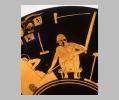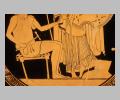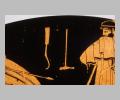| Collection: | Berlin, Antikenmuseen |
| Summary: | Interior: Hephaistos and Thetis |
| Ware: | Attic Red Figure |
| Painter: | Name vase of the Foundry Painter |
| Context: | From Vulci |
| Date: | ca. 490 BC - ca. 480 BC |
| Dimensions: | H. 12.0 cm., d. 30.5 cm. |
| Primary Citation: | |
| Shape: | Cup |
| Beazley Number: | 204340 |
| Region: | Etruria |
| Period: | Late Archaic |
Condition:
The cup is in excellent condition. Some of the details on the figure of Thetis on the interior have been lost due to the fractures there.
Decoration Description:
Interior: Thetis receiving Achilles' armor from Hephaistos. She holds a spear and shield, the shield device a bird carrying a snake in its claws. Hephaistos, seated on a cushioned stool on the left, holds up the helmet in his left hand, a hammer held in his right. A pair of greaves hangs on the wall between the two deities. At right is another hammer hanging from the wall of the workshop; beneath it is an anvil resting on a mound of earth. Hephaistos is bearded and wears a short, heavy tunic tied at the waist, perhaps a leather tunic to protect him from the heat of the forge. Thetis wears a chiton and mantle and a fillet over her hair. An inscription runs along the outline of the tondo above and behind her.
Sides A and B: foundry scene — the mortal equivalents of the smith-god on the interior. The tall cylindrical furnace, on the far left of side A, is being watched by two men. One man, bearded and naked but wearing a cap, crouches to the right of the oven, stoking the coals with a long piece of metal hooked on both ends through an opening in the furnace. The coals and fire are clearly depicted. The second youth crouches behind the furnace working the bellows. His eyes, shoulder and elbow are visible to its right. A round kettle with a lid sits on top of the oven. Four pinakes (depicting a standing man with a staff or torch, youth with a hammer, ram, seated figure with staff), two heads and red wreaths hang from goat's horns above the men; these probably represent votives rather than models (cf. AJA 84 (1980) 435-44
On side B, two craftsmen work on polishing an over-life size sculpture that is standing on a low, roofed platform while two bearded men stand watching. The sculpture is of a young, nude warrior wearing a helmet and carrying a shield and spear as he strides forward. He is set on a low base. The two bearded workmen, who are half the height of the sculpture, are working with scrapers to smooth the surface of the sculpture. One of the workmen, naked and wearing a cap, sits on a low stool while he works on a leg. The other man wears his chiton around his waist and stands as he works. To either side stand two older, well-dressed men, perhaps proprietors or master sculptors of the workshop. They lean on their staffs and both wear mantles, shoes and fillets (one red, one white). A hammer and scraper hang near the sculpture. Aryballoi and strigils hang near the onlookers. Sides A and B both carry inscriptions.
The statues are noticeably different in pose and rendering, that on side A being youthful, active and with the short hairstyle of contemporary early Classical sculptures, while the statue on side B stands in a stiffer, more Archaic pose, and wears the long hair popular in an earlier period. The pair of master sculptors or proprietors recalls the many pairs of sculptors attested in Greek literature, such Kritios and Nesiotes or Rhoikos and Theodoros.
Shape Description:
For the shape see Bloesch 73, Euphronios no. 19.
Inscriptions:
In the interior is the inscription:
Collection History:
The vase was discovered by Campanari. The museum acquired it through von Bunsen in 1837.
Sources Used:
AJA 84 (1980) 435-44
Other Bibliography:





